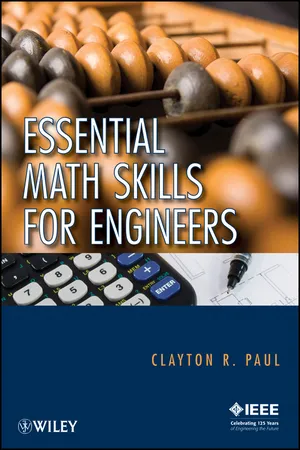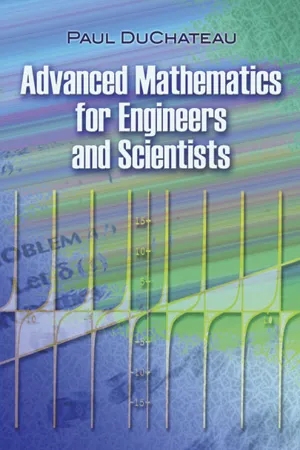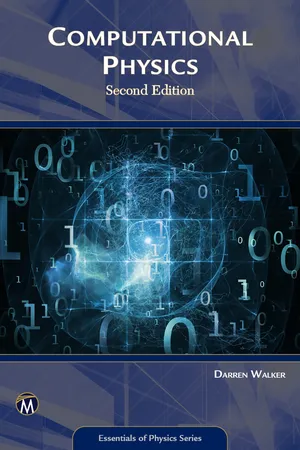Technology & Engineering
Second Order Nonlinear Differential Equation
A second order nonlinear differential equation is a mathematical equation that involves the second derivative of a function and includes nonlinear terms. These equations are used to model a wide range of physical phenomena in engineering and technology, such as vibrations, fluid dynamics, and electrical circuits. Solving these equations often requires advanced mathematical techniques and numerical methods.
Written by Perlego with AI-assistance
Related key terms
Related key terms
1 of 4
Related key terms
1 of 3
3 Key excerpts on "Second Order Nonlinear Differential Equation"
- eBook - ePub
- Clayton R. Paul(Author)
- 2011(Publication Date)
- Wiley-IEEE Press(Publisher)
y(x). You should be alert to this throughout your engineering studies. It is embarrassing not to know how to solve the differential equationonce you have learned to solve the differential equationas there are no differences in their solutions. We will consider only first- and second-order differential equations, meaning that the highest-order derivative will be first or second, respectively. Although higher-order differential equations occur frequently in engineering systems, they are only slightly more tedious to solve. However, you can easily extend to higher-order differential equations the methods we develop for first- and second-order equations.The equation is said to be linear if neither x(t) nor its derivatives are raised to a power greater than 1, and no products of x(t) and its derivatives appear. Note that there is a significant difference betweend2 x(t)/dt2and[dx(t)/dt]2 :The first is a second-order derivative and the second is a first-order derivative that is squared. An example of a nonlinear differential equation isThe equation is constant-coefficient if a and b are constants that are not functions of t. An example of a non-constant-coefficient differential equationIf a differential equation is either (a) non-constant-coefficient and/or (b) nonlinear, it is extremely difficult to solve, and generally only numerical, approximate solutions are obtainable! As was the case with algebraic equations, nonlinear and/or time-varying (nonconstant coefficient) differential equationsoccur throughout all of the engineering disciplines. But because they are so difficult to solve that an attempt at hand solution yields little or no insight into how a system behaves, we generally resort to solving them numerically in an approximate fashion using a computer or a calculator. Numerical solutions of differential equations are discussed at the end of this chapter. Throughout all of this you should keep in mind that the primary goal is to use mathematical skills to determine what the equations governing the system are telling us about how the system behaves. - Paul DuChateau(Author)
- 2013(Publication Date)
- Dover Publications(Publisher)
5Nonlinear Ordinary Differential Equations
I n the previous chapter we saw that the general solution to a linear differential equation of order n (or an n × n system of first order equations) contains n arbitrary constants of integration. Each choice of values for these constants produces a particular solution to the equation and every solution corresponds to some choice of values for the constants. The situation for nonlinear equations is less simple. Even for those special nonlinear equations where it is possible to construct solutions containing arbitrary constants, it may happen that there exist other solutions to the equation that correspond to no value of the constants. In general it is not even possible to find closed form solutions for nonlinear differential equations in terms of elementary functions. For that reason we will often have to be content with deducing qualitative properties of the solution from observations about the equation or system of equations.It is often possible, for examples, to determine the ultimate behavior of a nonlinear system without knowing precisely how the system evolves. This is the question of asymptotic stability. Similarly we may be able to determine if periodic solutions to a system exist without being able to construct such a solution exactly. Some simple tools for considering such questions are presented in this chapter:For nonlinear equations where the exact solution cannot be found and a qualitative description of the solution is insufficient, we may construct an approximate solution by numerical methods. Numerical solutions are discussed in Chapter 12 and have been used here to construct the figures in the solved problems which relate to Nonlinear systems.NONLINEAR EQUATIONS
The most general differential equation of order n in the unknown function y(t) and independent variable t is of the form F(t, y, y’, . . . , y (n) ) = 0. In general this equation has no solution expressible in terms of elementary functions, even in the case n- eBook - ePub
- Darren Walker(Author)
- 2022(Publication Date)
- Mercury Learning and Information(Publisher)
Using the method outlined above write a program that uses the fourth-ordered Runge–Kutta algorithm to adaptively integrate a differential function of your choice. My advice would be to use a simple differential equation that can be solved analytically for comparison to your adaptive routine. You should confirm that your routine is adapting to the local nature of the differential.6.3 SOLVING SECOND-ORDERED ODES6.3.1 Coupled 1st Order ODEsIt has been noted before that second-order ODEs occur most frequently in physics as they model many real physical systems. In general, we write a second-order ODE as. (6.27)Note that the function f has three variables namely the independent variable, the dependent variable, and the first derivative of the dependent variable.Although methods exist to solve higher-ordered differential equations, for example, finite difference method, it is far simpler to reduce the equation into a set of coupled first-order differential equations; the term coupled will become apparent shortly. We can do this by introducing secondary dependent functions such that and and thus we can rewrite Equation (6.27) as a pair of coupled, first-order ODEs:;.(6.28)They are coupled because the rate of change of variable is dependent on the variable , and the rate of change of variable is dependent on the variable contained in the function f . However, if we define and then Equations (6.28) can be rewritten in vector form, (6.29)or,(6.30)where and represent two-component vectors. Comparison of Equation (6.30) with Equation (6.18) shows that the problem of solving second-ordered ODEs is not primarily different from the first-ordered ODEs for which we have been developing solutions, only that now we have extra components.To illustrate this point, we can write Equation (6.1), which describes Newton’s second law of motion, as a pair of coupled first-order differential equations by introducing momentum as a secondary dependent variable. The momentum of a body of mass m in one dimension is defined as, (6.31)where is the velocity of the body at time t , and x
Index pages curate the most relevant extracts from our library of academic textbooks. They’ve been created using an in-house natural language model (NLM), each adding context and meaning to key research topics.
Explore more topic indexes
Explore more topic indexes
1 of 6
Explore more topic indexes
1 of 4


